I’ve been reviewing non-stick pans for years now and I’ve put more than 30 models through their paces. One thing I have noticed about these pans is their short lifespan. To find the best nonstick frying pan on the market, I tested 10 top rated skillets at home over three months.
If you love frying, sauteing or browning meats, poultry and fish as well as making omelets and pancakes, you’ll certainly appreciate the need to own a top-quality frying pan for cooking or preferably, the best nonstick pan.
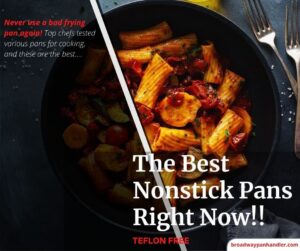
A non-stick pan is a type of cookware where the non-stick coating allows food to brown without sticking to the pan.
For most home chefs, the best frying pan is going to be nonstick, oven-safe, and cookware pieces that can withstand some wear and tear. In this nonstick frying pan reviews, consumer ratings and buying guide, you will know which nonstick pan is best after rigorous testing, and learn how to choose the best non-stick frying pan for your kitchen.
Top 4 non-stick frying pans, according to our testing
These are the top rated best nonstick frying pans to buy in 2025:
- Best overall nonstick pan: KitchenAid 3-Ply Stainless Steel Nonstick Fry Pan/Skillet.
- Best professional: All-Clad D3 Stainless Nonstick Fry Pan.
- Best nonstick pan for cooking: All-Clad D5 Brushed Stainless Steel 5-Ply Nonstick Fry Pan, Saute Pan Cookware.
- Best on a budget: Copper Chef 10 Inch Round Fry Pan.
To make this test as accurate as possible myself and the test team took real consumer reviews of nonstick pans, studied consumers reports and tested different frying pans from popular cookware brands such as All-Clad, KitchenAid, Tramontina, Cooper and Le Creuset. After series of nonstick pan reviews, we have shortlisted the best nonstick frying pans for home cooks and chefs who loves to fry food below.
Here then is a reviewed list of the best nonstick frying pans:
Best nonstick pan overall: KitchenAid 3-Ply Stainless Steel Nonstick Fry Pan/Skillet
KitchenAid 3-Ply Base Brushed Stainless Steel Nonstick Fry Pan/Skillet, 12 Inch
Our top pick of the best nonstick frying pan
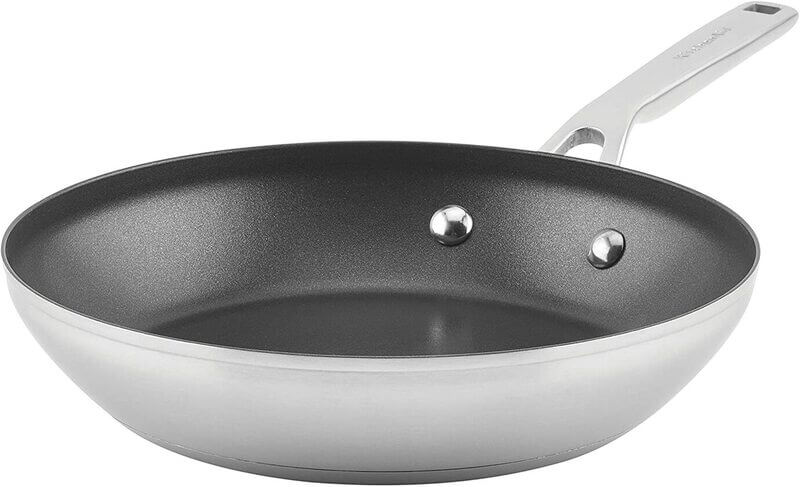
The KitchenAid 3-Ply Base Brushed Stainless Steel Nonstick Fry Pan/Skillet is an impressive pan designed with an extra thick layer of heat-conducting aluminum to eliminate hot spots by distributing heat evenly from edge to edge.
Personal experience: “This is a great little pan. I live in a household of two, but we always make enough for leftovers. If I need a non-stick pan for dinner, I’m usually reaching for this one. It has a VERY thick and heavy bottom. Pre-heating does take a little while because of that, even on a gas stove, but that’s alright. After a few months of use, the non-stick is still working great, and hasn’t chipped at all.
I think I would have preferred to get a size an inch or two bigger, but this still works for most of my needs. The lid from my 4 Qt pot fit this as well, which is handy. The sides are also well shaped. I often don’t need a spatula, as the sloped sides allow me to toss the food to stir. They go almost to vertical, so I rarely fling food about (meaning outside the pan) when using this method. Makes me feel like a professional chef.” Says Hymn Hummer
Why we picked it
cookware consistency.
What makes the KitchenAid Tri-Ply Stainless Steel Nonstick Fry Pan so much better than the competition is the constant improvement Kitchen Aid makes to its cookware’s. While some pans performed well in some areas and poorly in others, the KitchenAid ranked either at the top or near the top through every of our tests.
Great frying performance.
This standout performer handled every type of food we tested – from fried eggs to oven-baked cornbread to seared steak — with even heat and a slick, nonstick surface. Which explains why 3-ply pans are widely used in commercial and test kitchens.
“You need that layer of copper sandwiched between the aluminum for even heat distribution, and it also heats up the pan a lot faster than regular pans.”
You need that layer of copper sandwiched between the aluminum for even heat distribution, and it also heats up the pan a lot faster than regular pans.
Of the 10 pans we tested, the KitchenAid stayed on the cooler side, which resulted in steak that had a slightly more even sear compared to, say, the hotter Copper Chef — even though both cooked the meat to about the same rareness in the same amount of time.
Affordable quality
At around $80 (we’ve seen it for as low as $60), the KitchenAid strikes a balance between quality construction and affordable price. It’s also built to last the three to five years we expect from a nonstick pan. When we tried to damage it with metal utensils and a heavy whack against a concrete ledge, it came through with barely a scratch.
We were pretty impressed with the KitchenAid frying pan as soon as we took it out of the box. It has a particularly comfortable handle that makes it easy to balance the pan’s 2.5-pound heft (about the median weight of all 10 pans we looked at) and once we started testing, it continued to deliver great results similar to the other nonstick pans twice as expensive.
What you should know and points to consider
Care and maintenance.
Although we were able to successfully fry eggs and release cornbread without any added lubricants, you’ll probably want to add a little butter or oil if you want a truly slippery experience.
Also, even though it’s dishwasher safe, the KitchenAid’s care instructions suggest hand washing in hot, soapy water may “extend the life” of the pan. (Cleaning this pan is easy: A simple swipe of a soapy sponge left it looking shiny and new.) It also recommends you bring liquids to a boil before adding salt to keep white dots or pits from appearing on your nonstick surface.
Best professional frying pan: All-Clad D3 Stainless Nonstick Fry Pan with Lid
All-Clad D3 3-Ply Stainless Steel Fry Pan 12 Inch
Best stainless nonstick frying pan
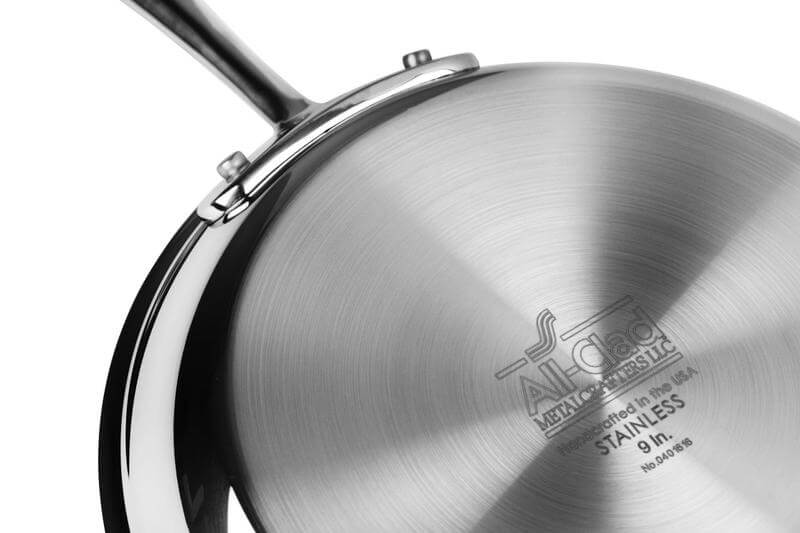
If you are in the market for a high quality pan for cooking or frying, the All-Clad Stainless Steel Try-Ply Nonstick Pan and Skillet is the best frying pan for serious chefs, home cooks and people who love to fry food.
Personal experience and what I liked: I have used cast iron, non stick, and stainless steel over the years. I bought the 10 inch first and was so impressed I bought the 12 inch as well. They heat evenly. I chose this for size and appearance, but especially for even heat cooking and ease of clean up. I have cooked meat, vegetables, and a variety of sauces. Which have come out incredibly delicious. Clean up is easy as long as you haven’t burnt the food in the pan. A liitle hot water, dish soap, and a green scrub will do the trick. Great quality at a modest price.
Why we picked it
Upgraded quality.
The All-Clad Stainless Steel Try-Ply Nonstick Pan and Skillet is a comparable upgrade from the KitchenAid, both in looks and performance. In our test kitchen, we noticed both the All-Clad stainless steel frying pan and the Kitchen aid pan had same weight and size, similarly induction-friendly and oven-safe (up to higher 600 degrees), and with a quality nonstick coating.
It also performed about the same in damage testing and cooking, and slightly outperformed our top pick in our fried egg test.
It’s Perfect for the serious chef.
The All-Clad series is designed (and priced) for a more serious kitchen. The profile and even-heat performance make it a stylish staple for the chef who cooks on high.
We tested two All-Clad nonstick pans to see if the five alternating layers of steel and aluminum in the d5 were better than its tri-ply sister pan, the All-Clad Stainless Nonstick Fry Pan. We ended up liking both a lot, but from a performance standpoint, the tri-ply actually edged out the d5 in egg flip ability and damage resistance.
What we disliked, what you should know and points to consider
It needs professional and careful handling.
All-clad makes a great pan, no doubt. However, the handle on this All-Clad Stainless Steel Fry Pan Cookware isn’t as comfortable to hold and maneuver like the other best pans for cooking. It has a curved outer edge that dig into your hand a little when you grip them on the stove or while scrubbing in the sink.
That said, All-Clad is a well-known and well-loved luxury kitchen brand, and if you need the best nonstick pan for cooking, you won’t go wrong with any of the high-quality nonstick frying pans from All-cald.
Best non-stick pan for cooking: All-Clad D5 5-Ply Brushed Stainless Steel Fry Pan
All-Clad D5 5-Ply Brushed Stainless Steel Fry Pan 8 Inch
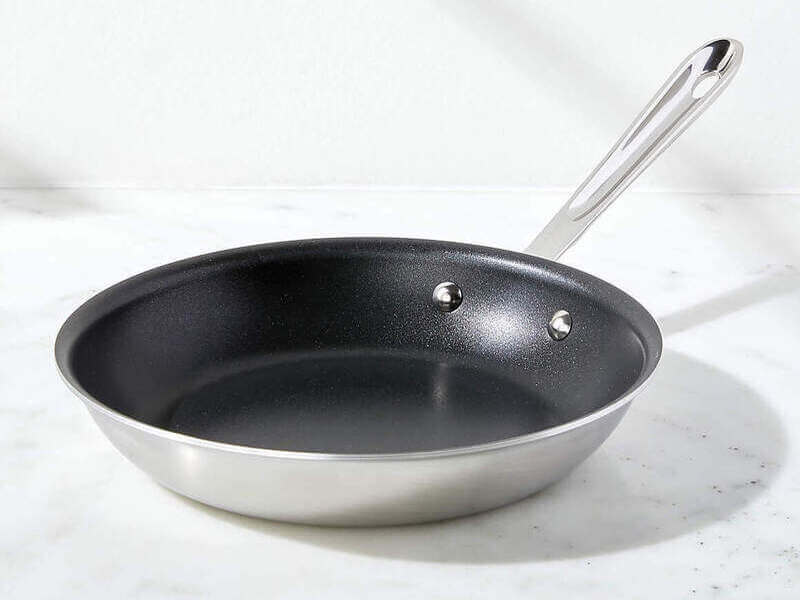
Sear, brown, and pan fry everything from eggs to meat, with the All-Clad D5 Fry Pan. The pan’s flat bottom and flared sides make it easy to toss food or turn it with a spatula. In our test kitchen, food cooked with this pan tasted better when used with oil.
There are certainly less expensive skillets out there, but All-Clad usually gets my dollars because their product quality is excellent. I own All-Clad pans that I’ve had for 25 years. While I’ve only used this pan for 3 months since it arrived, it is everything that I expected it to be: well-constructed, nicely balanced, great non-stick properties, and it feels good in the hand while using. It’s a solid piece of kitchen hardware that I expect to have for many years to come.
Ideal for cooking with oil.
The pan is ideal for cooking with oils to help food develop rich flavor, bright color, and crisp texture. The PFOA-free nonstick coating is durable and provides excellent release. Item Numbers
All-Clad d5 stainless steel frying pan cookware, maintains the classic style of the original stainless cookware with new technology and enhancements.
Exceptional Heating performance.
As with all cookware from All-Clad’s D5 collection, this pan is constructed with bonded stainless steel for exceptional heating performance, especially in induction cooking.
The d5 brushed stainless steel collection has a patented five-ply construction made up of 5-alternating layers of stainless steel and aluminum that delivers superior heat distribution without hot spots.
The Design.
All Clad d5 is designed with larger stainless-steel handles that have more rounded edges to improve comfort and offer better balance as well as rolled (flared) rims for precise drip-free pouring.
Where applicable newly designed loop/helper handles improve grip & stability when lifting. The lid handle features a deeper clearance between the handle and lid. The All-Clad d5 nonstick pan is compatible with all cooktops, including induction. It is oven and broiler safe and can be washed in the dishwasher. Although we recommend you use your hands when it comes to nonstick cookware care and maintenance.
Best budget nonstick frying pan: Copper Chef 10-Inch Round Nonstick Fry Pan
Copper Chef 10 Inch Round Frying Pan With Lid
The cheapest nonstick frying pan without Teflon
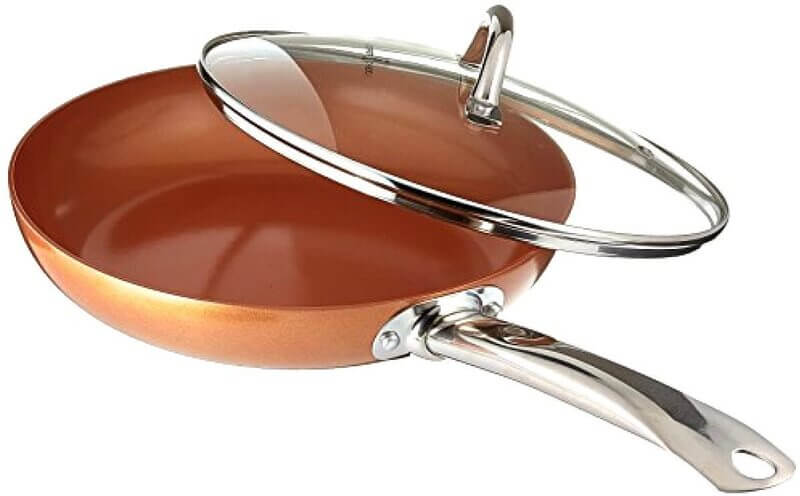
Why we picked it
Great deal.
We’re going to be honest: We expected this pan to fail. Anything with the bright red “As Seen on TV” logo comes with instant skepticism, but the more we tested the Copper Chef Nonstick Pan, the more impressed we were.
Its “As Seen on TV” infomercials don’t lie – the nonstick capabilities are seriously impressive. Eggs and even steak slide around on this pan like marbles on a tabletop, and that’s without adding oil. And all of this for around $20.
Emphatically nonstick.
The Copper Chef gave us the best fried egg in our tests and it was the easiest egg to fry. Although the KitchenAid did very well in this test, there was still a slight resistance – that is, a little bit of stick – when we slid in our slotted turner and tried to flip the egg without breaking its yolk. The Copper Chef had no resistance at all.
PTFE (Teflon), free.
Copper Chef is one of the pans we tested that’s not coated with PTFE – Teflon. The Copper Chef is aluminum (copper is just its color) with a Cerami-Tech ceramic nonstick coating. Ceramic coatings are known for not having the lifespan of PTFE – another reason for that small price tag – and we discuss why PTFE isn’t the risk some consumers think below.
Every expert we spoke to and every study we read confirmed that there is no reason to avoid Teflon, and all our top picks are PFOA-free, which is what most Teflon-related health concerns are about. That said, if Chef Nonstick fry Pan is the best frying pan on a budget for you.
Points to consider and What you should know
It’s hotter and less hearty (Use a hot pad).
The Copper Chef is not a perfect piece of cookware, particularly when it comes to heat and wear and tear. The majority of the pans we tested, including the KitchenAid and the All-Clad pans, had handles that stayed cool while we fried eggs and seared steak. The Copper Chef handle got notably hot. You’ll want to use a hot pad or an oven mitt while stovetop cooking.
It won’t last you a very long time.
You’re also going to want to avoid banging it around your kitchen. Even though it made it through our fork-scratch test without a mark, we managed to put a huge dent in it during our damage testing. Also know that ceramic coatings wear away much faster than their PTFE counterparts, which means you’ll be replacing this in a couple of months or years.
How to Find the Right Frying Pan for You and Your Kitchen
Avoid nonstick pans with textured cooking surfaces
Some nonstick frying pans come with textured surfaces, such as the Frieling Black Cube Fry Pan and the Circulon Symmetry Hard-Anodized Nonstick French Skillet. It sounds a little like a no-brainer, but we found that the pans with textured surfaces were consistently less nonstick than pans with smooth surfaces – and the experts agree.
A raised pattern on a nonstick pan pretty much negates its nonstick ability. Food tends to grip to the texture, so a smooth-bottomed pan is ideal in this category.
Braun
Why would a nonstick frying pan have a textured surface?
In most cases, it might be so that you can use metal utensils on the pan. The Frieling pan was the only one to pass our fork scratch test with no marks whatsoever — so those surfaces are good for something!
Pick your ply
Of our top picks and honorable mentions, two pans are tri-ply: the KitchenAid Tri-Ply Stainless Steel Nonstick Skillet and the All-Clad Stainless Nonstick Fry Pan. The All-Clad d5 Stainless Nonstick Fry Pan and the Swiss Diamond Prestige Clad Nonstick Fry Pan all have five layers — which helps explain why they are typically more expensive than the tri-ply options.
Methodology: How We Tested and Picked the Best Nonstick Frying Pans
Universally compatible and medium-sized oven-safe pans
We started with a list of 68 nonstick frying pans from retailers including Williams Sonoma, Kmart, and Amazon, then by looking for some basic criteria we narrowed the field down to 10 to hands-on test ourselves.
First, compatibility with all types of stovetops, including induction. Second, the versatility conferred by being oven-safe, because you can, for example, brown a steak on the stove and put it directly into the oven without having to transfer it into a baking dish.
We also opted to only test 10- and 11-inch pans. This is a good size for cooking two fried eggs or a three-egg omelet, but if you’re interested in more (or less), most of the models we tested come in a range of sizes, typically from 9 inches up to 12.
Nonstick test
Want to get a really quick sense of how good your nonstick pan is?
Fry an egg on it. If you can successfully fry an egg without the white sticking all over the pan and with the yolk intact, you’ve got a keeper.
We heated each of our test pans for two minutes, and then fried eggs on low heat without adding any oil or butter, specifically because we wanted to test the nonstick surface of the pan itself – without any additional lubricants.
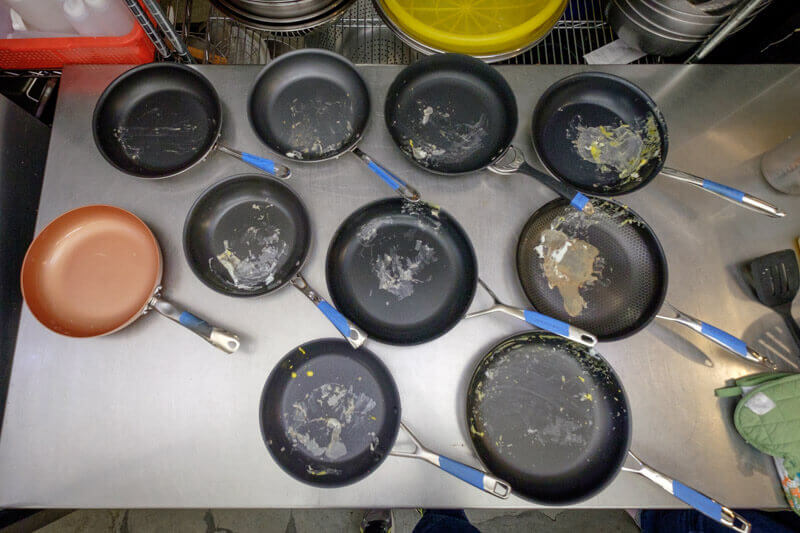
Same goes with our cornbread. We mixed the batter and spread it into each nonstick pan without any oil or butter. After 15 minutes in a 400-degree oven, we tested to see which could release a wedge leaving the fewest crumbs or crusts behind.
Even heat distribution
We did two tests to get a sense of heat distribution. The first was heating two cups of cold water over medium heat to see where those mini bubbles appeared first, and if there were any hot or cold spots as the water grew warmer.
We also tested searing 1-inch round eye steaks over medium-high heat to see if any pans cooked hotter, or didn’t release meat as well.
All 10 pans handled the meat well without sticking. And all achieved about the same rareness after six minutes – but some pans definitely seared the meat more than others. When we double-checked each pan’s temperature with an infrared thermometer, we saw about a 135-degree temperature swing, but nothing that would cut a pan from its running.